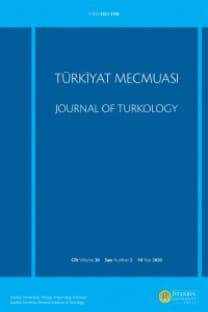HZ. MUHAMMED’İN MUHTASAR ŞEMÂİL-İ ŞERİF TERCÜMESİ'İNDE GEÇEN VASIFLARI
Makalenin konusu Mehmet Raif Efendi’nin Muhtasar Şemâil-i Şerif Tercümesi’nde tespit ettiğimiz Hz. Muhammed için kullanılan başlıca sıfatlardır. Osmanlı Türkçesiyle yazılmış olan bu şemail tercümesinde Arapça ya da Farsça tamlama olarak kullanılan bu sıfatların anlamları açıklanmış ve kitapta geçtiği yerler belirtilmiştir. Eserde geçen bu sıfatları mütercim bağlamına göre çok uygun bir şekilde kullanmıştır. Şemâil kelimesi şimâlin çokluğudur. Sözlükte “karakter, kişilik, tabiat, huy, ahlak; iyi, hoş seçkin özellikler” gibi anlamlara gelen kelime “Bir şahsın hayat hikâyesini içine alan eserler için” kullanılmış, Hz. Muhammed’in beşerî yönünü, yaşama tarzını ve şahsî hayatını anlatan eserlere genellikle bu ad verilmiştir. Hz. Muhammed’in mükemmel beşerî yönü ve bedenî tavsifinin bütünü için şemail kelimesinin kullanılması gittikçe yaygınlaşmıştır. Şemâillerde Hz. Muhammed’in fizyonomisi, beden yapısı, karakteri, yaşayışı ve giyiniş tarzı, hususi hayatı tasvir edilmiştir. Kur’an’da Hz. Muhammed’in bir beşer olduğu zikredilmiş, fakat Hz. Muhammed’in beşerî ve fiziki özellikleri anlatılmamış, onun ahlakı ve davranışları hakkında bilgi verilmemiştir. Bu bağlamda sulhta ve savaşta yaptıklarıyla tüm insanlara en güzel örnek olmuştur. İşte Hz. Muhammed’in bütün bu vasıfları şemail adı verilen eserlerde verilmiştir.
Anahtar Kelimeler:
Hz. Muhammed, Klasik Türk Edebiyatı, şemail, hilye, beşer, dış görünüş
CHARACTERISTICS of PROPHET MUHAMMED RECORDEN IN MUHTASAR ŞEMÂİL-İ ŞERİF TERCÜMESİ (CONSIZE TRANSLATION OF THE BLESSED APPEARANCE OF PROPHET MUHAMMED)
The subject of the article is the main adjectives used for the Prophet Muhammed that we noticed in the book of Mehmet Raif Efendi called Consize Translation of the Blessed Appearance of Prophet Muhammed (Physical characteristics of the Prophet Muhammed). In this translation of Şemail which was written in Ottoman Turkish, it has been explained the meaning of Arabic or Persian phrases and it has been mentioned the places of these phrases that used in the book. The adjectives in the book have been used by the interpreter in a very appropriate way according to the context. The word “şemail” is the plural of “şimal”. The meaning of şimal is given in dictionary as character, personality, temperament, morality, well, pretty outstanding features. And also this word refers to literature that covers the life story of a person. Usually this name has been given for the literature describes the human aspect of the Prophet Muhammed, his personal life and living style. The use of the word “şemail” becoming increasingly widespread defining the Prophet Muhammed’s excellent human aspects and describing his physical features. It has been described the Prophet Muhammed’s physiognomy, physique, character, his private life and style of dress in these “Şemail” literature. It has been mentioned in the Holy Qur’an that the Prophet Muhammed is a human but the knowledge is not given involving his physical and human characteristics, his ethics and behaviours. In this context the Prophet has been the most beautiful example for all the people in terms of what he did in peace and in war. All these characteristics of the Prophet have been given in these “Şemail” literatures.
Keywords:
Prophet Muhammed, Classical Turkish Literature, şemail, hilye, human being, physiognomy,
___
- Ebû İsa Muhammed b. İsa b. Sevre es-Sülemi Tirmizî, eş-Şemâilü'n-Nebeviyye ve'lhasailü'l-Mustafaviyye, haz. Fevvaz Ahmed Zemerli, Beyrut 1996.
- GÜNGÖR, Zülfikar, “Türk Edebiyatında Türkçe Manzum Hilye-i Nebevîler ve Nesîmî Mehmed’in Gülistan-ı Şemâili”, s.2 nakleden: Sema Gülmez, Cevrî İbrahim Çelebi ve Hilye-i Çihar-Yar-ı Güzin Adlı Eseri, 2006, yüksek lisans tezi, İzmir.
- Hasan Hüsameddin Nakşibendî, Kitâb-ı Şerh-i Şemâil, Bulak 1255.
- İmâm Tirmizî, Şemâil-i Şerîf Şerhi, tercüme ve şerh: Yaşar Kandemir, I-III, İstanbul 2015.
- KANDEMİR, M. Yaşar, “Şemâil”, DİA, C. 38, İstanbul 2010, s. 497-500.
- --------------, “eş-Şemâilü’n-nebeviyye” DİA, C. 38, İstanbul 2010, s. 500-501.
- Mehmed Râif Efendi, Şemâil-i Şerif: Efendimiz’in Güzelliği ve Ahlakı, haz. A. Azmi Bilgin, İstanbul 2013.
- PAKALIN, M. Zeki, Osmanlı Tarih Terimleri ve Deyimleri Sözlüğü, İstanbul 1993.
- YARDIM, Ali, Peygamberimiz’in Şemâili, İstanbul 1997
- Başlangıç: 1925
- Yayıncı: İstanbul Üniversitesi Türkiyat Araştırmaları Enstitüsü
Sayıdaki Diğer Makaleler
DIMAŞK SELÇUKLU MELİKİ ERTAŞ BİN TUTUŞ
TÜRK MENŞELİ BAZI ÇİN AİLELERİ: HUN, LI, JİN VE YUWEN
GEÇ DÖNEM ÇAĞATAY TÜRKÇESİYLE YAZILMIŞ “DÎVÂNE BÛRAK KISSASI”: METİN, DİL VE ÜSLUP İNCELEMESİ
EÇMİYADZİN KATOGİKOSLUĞU VE RUSYA DEVLETİ ARASINDAKİ İLİŞKİLERİN BAŞLANGICI
EVLİYA ÇELEBİ’YE GÖRE II. VİYANA MUHASARASINDA KIRIM HANI’NIN YANLIŞ TUTUMUNUN SEBEPLERİ
The OTTOMAN PRACTICES of the KANUN of DUKAGJINI: The METHOD of CİBAL
LEV NİKOLAYEVİÇ GUMİLËV VE ETNOGENEZ TEORİSİ
DUKAKİN KANUNLARININ OSMANLI UYGULAMASI: CİBAL USULÜ
LUTFÎ DİVANINDA TEKRAR GRUPLARI
